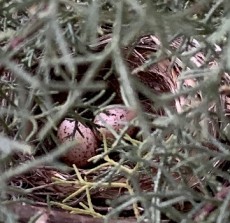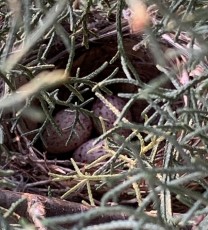She Laid Eggs
She Laid Eggs1
Recently a brown-eared bulbul2 has been flying really close to the window of my teaching room. Sometimes we are so close like 1 meter from each other that I can see her eyes, her beak3 and her feathers4 so clearly.
At the same time5, Will started saying "Recently I often see brown-eared bulbuls around our house. Especially when the crows are around. I wondered if they are being nervous because they are nesting?"
We soon found out. There was a nest! There was a nest right against my window! Yesterday we saw 2 eggs. This morning 3!


The parents were not around6 when we saw them. Interestingly, Will told me that after they lay eggs, they don’t have to start warming them right away. For about 2 weeks, the eggs can stay in the nest as they are, but once the parents start warming the eggs, they can’t leave the nest. They have to keep them warm all the time7.
That’s how they can raise all the babies at the same time. If the eggs hatch8 at different times, the parents have to take care of each baby bird in a different growing stage in a different way. That’s not easy.
So when the mother first sits in the nest, that’s the time the clock starts9!
We learned that usually brown-eared bulbuls lay 3 to 5 eggs. I wonder how many more we’ll see in the next few days?
We are looking forward to hearing the baby birds start chirping10 literally right next to our house wall!
◆1 lay eggs : 卵を産む
◆2 brown-eared bulbul : ヒヨドリ
◆3 beak : 嘴
◆4 feather : 羽
◆5 at the same time : 同時に
◆6 be around : その辺にいる
◆7 all the time : ずっと
◆8 hatch : (卵が)かえる
◆9 the clock starts : カウントが始まる
◆10 chirp : ピヨピヨ鳴く
|
卵を産んでくれました!
最近ヒヨドリが私が教室に使っている部屋の窓のすぐ近くをよく飛んでいました。時にはお互いの距離が1mぐらい近くまで来るので、目や嘴や羽までハッキリと見えるほど。
丁度時を同じくして、ウィルも「最近よくヒヨドリが家のまわりを飛んでいるのを見るんだよね。特に僕のカラスがいるとき。巣作りでもしていて神経質になっているのかなぁ?」と話し始まりました。
そして、すぐに理由が分かりました。巣があったんです!それも私の部屋の窓からすぐのところに!昨日は卵が2つありました。そして今朝は3つ!
私たちが見たときは親鳥は近くにいませんでした。面白いことに、ウィルによると、ヒヨドリは卵を産んでから、すぐに卵を温め始めなくても良いんだとか。大体2週間は卵はそのままでも大丈夫。但し、一度親鳥が卵を温め始まったら、ず~っと温めていなければならないそうです。
そうすることによって、同じ成長段階のヒナを育てられるという訳。もしこれが、ヒナがバラバラのタイミングで孵化したら、親鳥は成長段階の異なる赤ちゃんをそれぞれ違った子育てをしなければならなくなるということ。それは確かに簡単なことではありません。
だから、母鳥が巣に落ち着いたら、そこからが一斉抱卵スタート!
普通ヒヨドリは3~5個の卵を産むそうです。この数日の間にあと何個卵が産み落とされるでしょう。
ヒナが家の外壁のすぐそばで鳴き始めるのを今から心待ちにしています!
|
2022年6月16日 at 5:52 PM, under
≫≫≫ Nature. コメントはまだありません
Both comments and trackbacks are currently closed.











